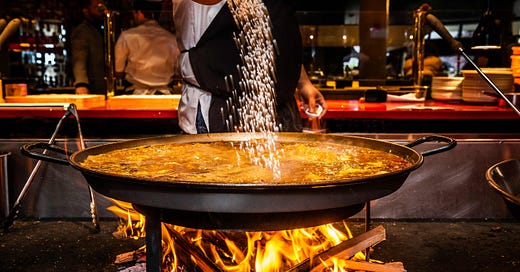My friends, hola! Happy Monday!
Today, I am writing about a topic I have talked with you about in the past…paella! This classic Spanish dish was a big part of my childhood growing. I spent many Sundays helping my father make a giant paella over an open fire. Sometimes we would make it in a park in the mountains—and we would have as many as 100 people!
These days when I make paella I usually don’t have that many people, but I still follow the same process as my father did—cooking it over an open fire in my backyard.
Now, I’ve already written a lot about paella here on Longer Tables…how to make the most authentic Valencian paella, how to launch it into space, and even how I helped create the paella emoji. And when my daughters and I made our TV show José Andrés and Family in Spain, we even cooked paella in its birthplace of Valencia (well, actually I made them enter a paella cooking competition!) But I haven’t talked about the most important ingredient of paella—the heart of it—the rice!
When I am back home in Spain, I usually use Bomba rice, a type of pearly white short grain rice from Valencia that is great at absorbing liquid. There are a handful of other types of rice that are acceptable in a true paella: Sénia, Bahia, Albufera, and more. Bomba rice is the most common in Spain, but it’s usually very hard to find outside of the country. Luckily, the Calasparra variety, which is very similar to Bomba, is an excellent substitute and you can find it easily here in the US.
Calasparra rice is an amazing rice that comes from the mountains of the Calasparra region in the province of Murcia, outside of Alicante. It is grown with pure mountain water that’s delivered by aqueducts originally built by ancient Roman engineers and updated by the area’s Moorish population a thousand years ago. How amazing!
Like Bomba and the other varieties, Calasparra is perfectly suited for making paella. That’s because all of these types of rice are arroz redondo, or round, instead of long, varieties, with a short-grain. What makes these two varieties of rice so perfect for paella is their ability to soak up so much liquid…it’s like they have the DNA of paella inside them. They are like sponges (or bombs!), expanding crosswise (instead of along the length) up to three times their size. This means the rice absorbs all those intense flavors from the stock and juices from the other ingredients without becoming sticky or mushy. Nothing is worse than mushy paella (I’m looking at you, arborio rice)!
So if you want to try to make your own paella, go to your local Spanish market or specialty food store, or take a look at Mercado Little Spain’s online shop and you can either get a bag of Calasparra Rice, or an entire Paella Making Kit, which includes a 15" traditional steel paella pan, which helps achieve the socarrat (the crispy, caramelized bottom later of rice) at the bottom of the pan; a cooking base with traditional Valencian aromas of rosemary and saffron, to get you started, as well as the Calasparra rice, Arbequina olive oil, and Spanish saffron for seasoning. (Don’t forget…many of you have a 15% discount to the store—look at your welcome email if you forget the code!!) All you need to do is add rabbit and chicken if you’d like to make a true Valencian paella (recipe here), or some vegetables—maybe I’ll share a vegetarian recipe for a paella-style vegetable rice on Wednesday…?
My friends, I hope that you try making your own paella and let me know how it goes when you do!






I'd love that vegetarian recipe! Thank you Chef.
Looking forward to the vegetarian recipe!